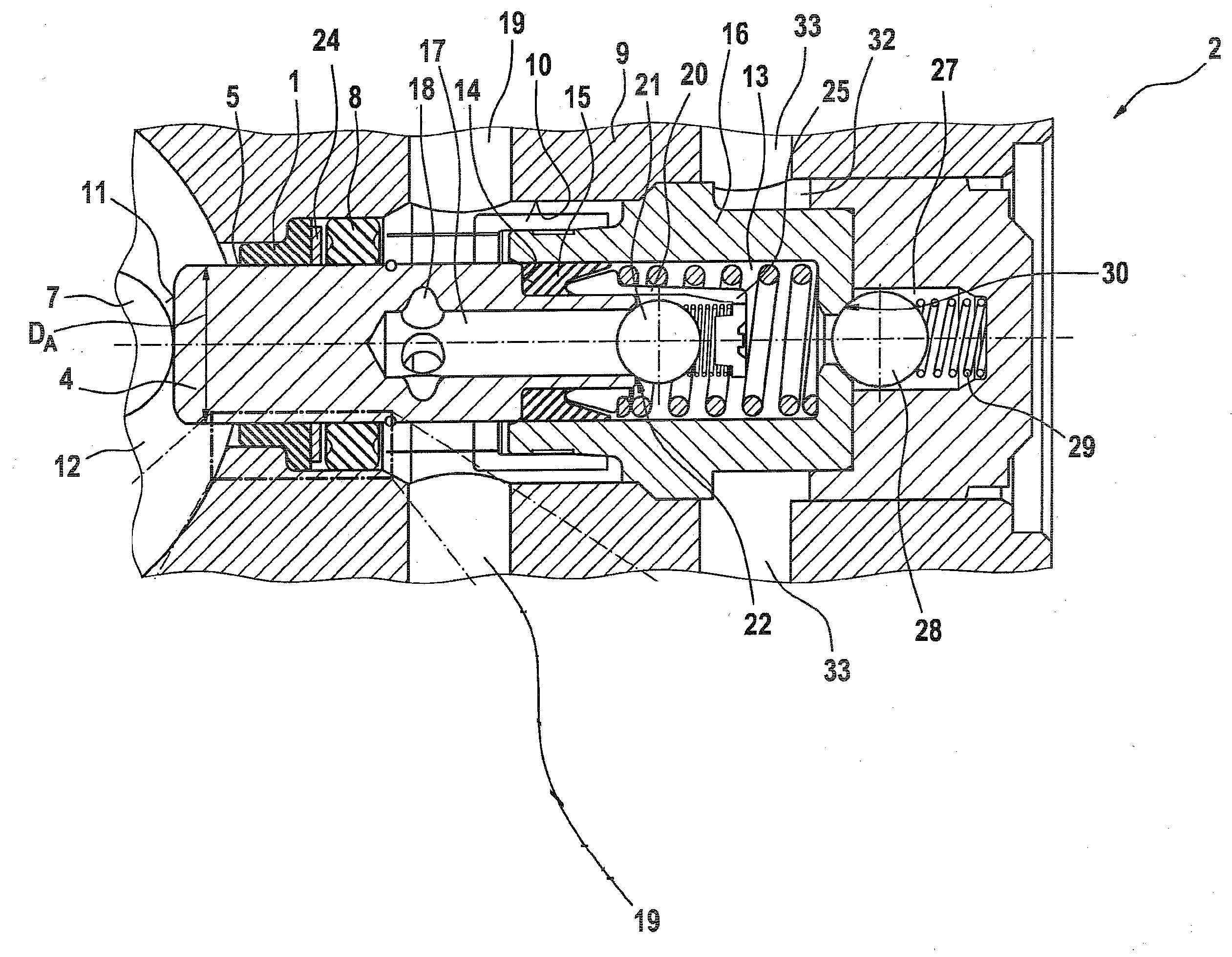[0007]The invention is based on the concept of embodying a guide ring for guiding the piston; the guide ring is penetrated by the pump piston or pump rod in such a way that it damps the radial deflection motions of the pump piston or pump rod that can be ascribed for instance to a radial force component exerted by an eccentric on the pump piston or
piston rod. Because the radial impacts of the pump piston or piston rod are damped by the guide ring, in particular in such a way that the speed of the deflection motion is reduced and / or the amplitude of the radial impacts is minimized, a ring seal disposed preferably axially adjacent to the guide ring is capable, even at low temperatures and at a high axial loading speed of the pump piston or piston rod, of following the radial deflection motions, that is, the radial impacts of the pump piston or piston rod. As a result, in turn, a durable contact of the ring seal with the pump piston or piston rod is assured, which in turn prevents the formation of a crescent-shaped gap between the pump piston or piston rod and the ring seal, or at least minimizes the size of a crescent-shaped gap. The embodiment according to the invention of a guide ring has the
advantage that even with conventional ring seals, sealing off of the high-pressure region of the pump from a low-pressure region, in particular an eccentric chamber, can be ensured. It is understood that the tightness can be further improved if a ring seal, described in DE 10 2005 046 048 A1, is provided in addition to a guide ring embodied in accordance with the concept of the invention.
[0009]An embodiment in which the inner
diameter of the at least one lip, in the uninstalled state, is less at least in one region and preferably in a free end region than the outer
diameter of the pump piston or piston rod is especially advantageous. As a result, a tight contact of the lip with the pump piston or piston rod is achieved. In such an embodiment, the first lip not only has the function of a damping element but also simultaneously serves as a stripper ring for stripping off
dirt particles, which can be carried in particularly from the direction of an eccentric chamber. Thus the lip effectively prevents
dirt particles from advancing to the ring seal, and the service life of the ring seal is increased as a result, because of reduced wear. In contrast to known guide rings, by means of the embodiment of the guide ring as closely contacting the pump piston or piston rod, guidance play between the pump piston or piston rod and the guide ring, and at least between the lip of the guide ring and the pump piston, is avoided.
[0010]In a refinement of the invention, it is advantageously provided that the guide ring has at least one second, radially resilient lip, which in particular extends all the way around. The two lips that in particular extend all the way around are preferably spaced apart axially from one another, in order to achieve optimal guidance of the pump piston or piston rod and simultaneous damping of radial deflection motions of the pump piston or piston rod. Moreover, such an embodiment of the guide ring offers the
advantage that a support ring previously used, which is disposed axially between the ring seal and the guide ring in order to prevent the seal from being drawn into a guide gap between the guide ring and the pump piston or piston rod, can be dispensed with as needed, since the second lip takes on the task of a support ring.
[0011]An embodiment in which the two lips are disposed with free end edges, extending all the way around and pointing in opposite axial directions, is especially advantageous, and it is within the scope of this refinement that the end edges are additionally inclined in the direction of the pump piston or in the direction of the piston rod. Particularly in such an embodiment, the drawing in of the ring seal into a region radially between the guide ring and the pump piston or piston rod is advantageously avoided.
[0013]An embodiment in which the guide ring is made of a
thermoplastic and in particular high-strength
thermoplastic material is especially preferred, so that on the one hand the guidance task and on the other the damping action can be securely attained. It is especially preferable if the guide ring is produced as a one-piece injection-molded part from a high-strength
thermoplastic material. The thermoplastic material should be selected such that it does not lose its damping action, that is, its radially (slightly) resilient action, even at temperatures around approximately −30° C.
[0015]Preferably, the guide ring is disposed axially between an eccentric chamber, in which an eccentric is driven to rotate, and a ring seal. It is especially advantageous if the guide ring is equipped with at least one radially resilient lip, which preferably extends all the way around and which is disposed with its free end edge pointing in the direction of the eccentric chamber. In this embodiment, the first lip has in addition to the
damping function a
dirt stripping function, which prevents the penetration of dirt particles into a region between the ring seal and the guide ring. This leads to a longer service life of the ring seal.
 Login to View More
Login to View More  Login to View More
Login to View More 


